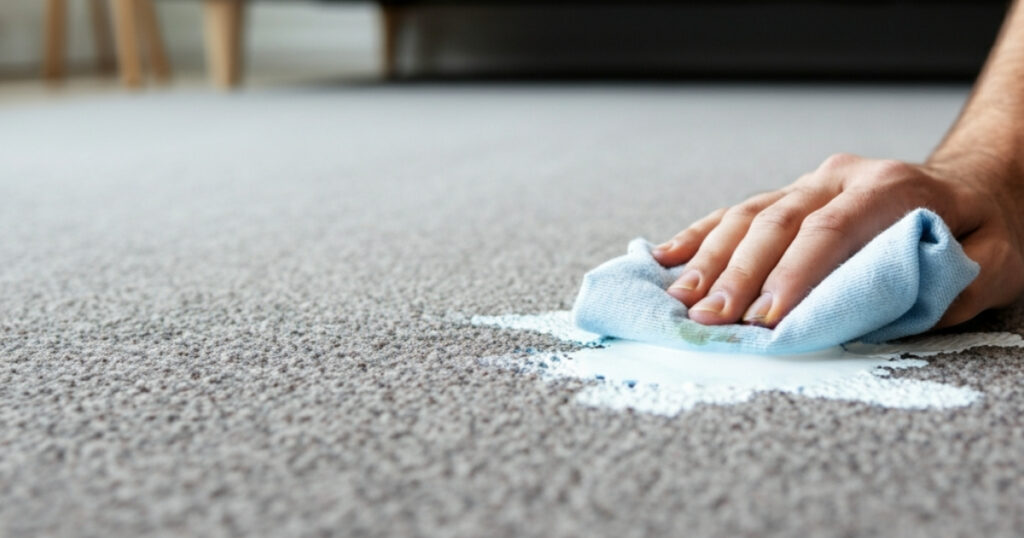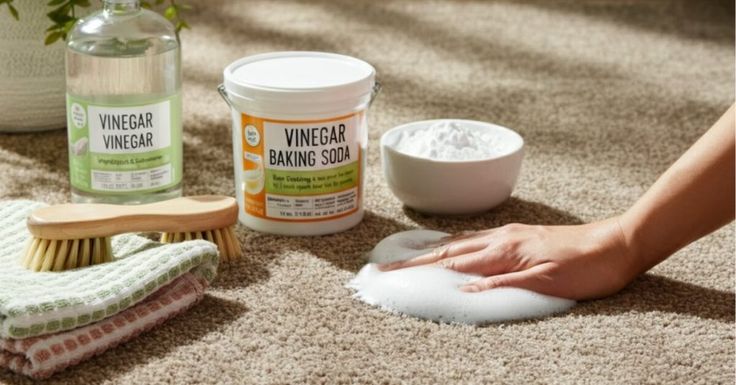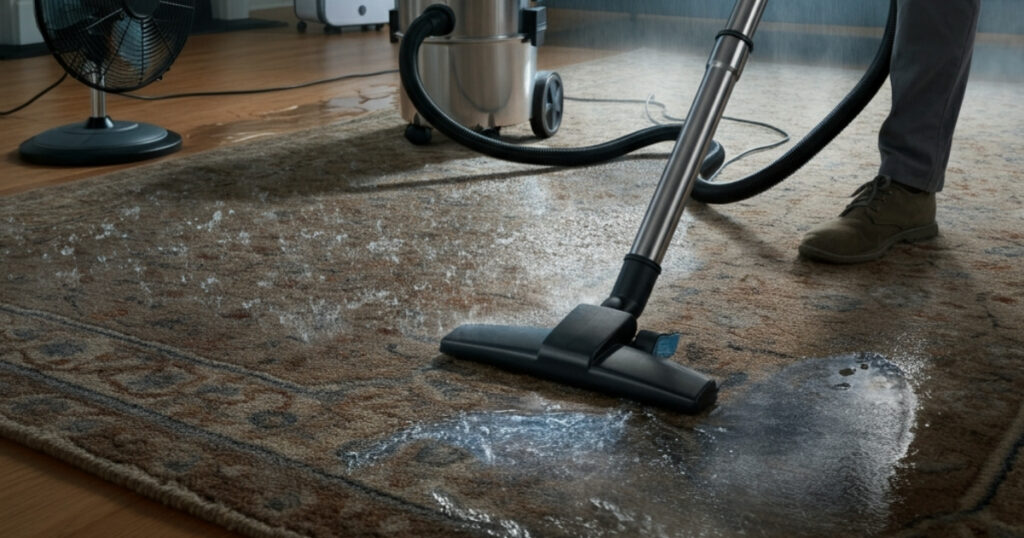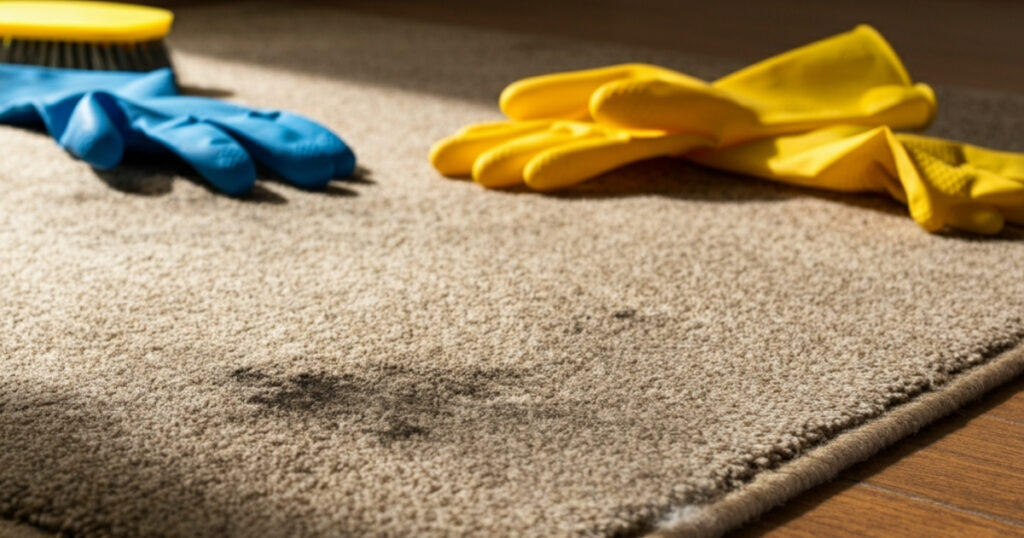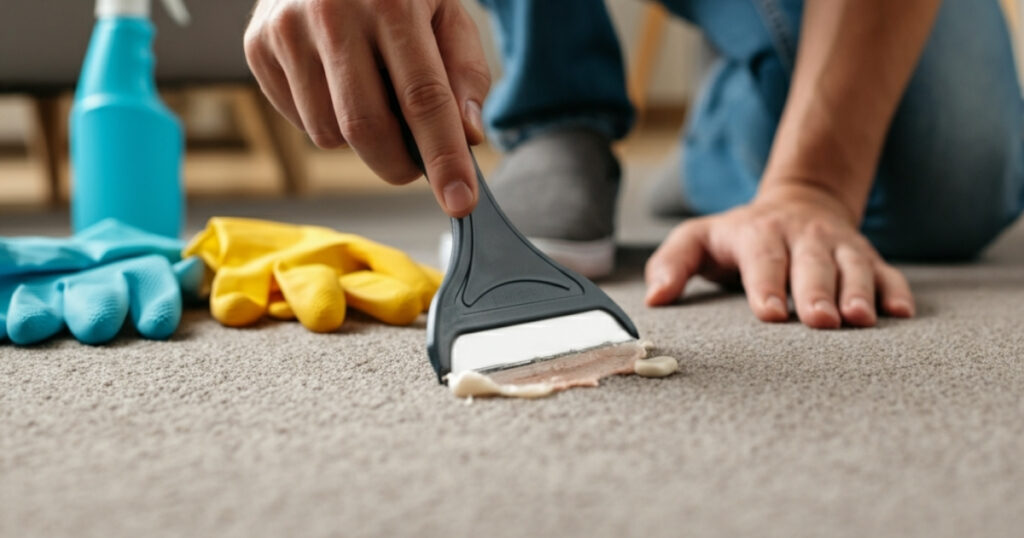As an Amazon Associate, I earn from qualifying purchases.
A fresh coat of paint can transform a room, but a stray drip on your carpet can feel like a disaster. Knowing how to get paint out of carpet effectively can save you from a permanent stain and the expense of a professional cleaning or replacement. Whether you’re dealing with a fresh spill or a dried-on spot, the right technique can lift the paint without damaging your carpet fibers.
This guide provides a comprehensive walkthrough of the methods and materials you need to tackle paint stains. We will cover how to remove both wet and dry paint, addressing water-based and oil-based types. By following these step-by-step instructions, you can confidently handle paint spills and restore your carpet to its original condition.
Contents Overview
First Steps: What to Do Immediately After a Spill
When paint hits the carpet, acting quickly is your best defense. The sooner you address the spill, the higher your chances of removing it completely.
1. Don’t Rub or Scrub the Stain
Your first instinct might be to scrub the paint away, but this can make the problem worse. Rubbing pushes the paint deeper into the carpet fibers and can spread the stain over a larger area. Instead, you’ll want to gently blot the area.
2. Blot the Excess Paint
Take a clean, dry cloth or a stack of paper towels and gently press down on the fresh paint spill. This action will absorb the excess paint from the surface. Lift the cloth and use a fresh section for each blot to avoid reapplying paint to the carpet. Continue this process until you are no longer lifting any wet paint.
3. Identify the Type of Paint
Before you apply any cleaning solution, you need to know what kind of paint you’re dealing with. The removal method depends heavily on whether the paint is water-based (like latex or acrylic) or oil-based.
- Water-Based Paint: This is the most common type of paint for interior walls and is the easiest to clean. Check the paint can for terms like “latex,” “acrylic,” or instructions that say to clean up with soap and water.
- Oil-Based Paint: This type is more durable and also more difficult to remove. The paint can will typically mention “oil-based” or “alkyd” and will recommend using mineral spirits or turpentine for cleanup.
If you don’t have the paint can, you can test a small amount of the spill. Apply a little rubbing alcohol to a white cloth and dab the stain. If the paint transfers to the cloth, it is likely water-based. If it doesn’t, it is probably oil-based.
How to Get Wet Water-Based Paint Out of Carpet
Wet water-based paint, such as latex or acrylic, is the most straightforward type of paint to remove from carpeting if you act fast.
Materials Needed:
- Clean cloths or paper towels
- Warm water
- Mild dish soap
- A small bowl
- A sponge or soft brush
- A wet/dry vacuum (optional but helpful)
Step-by-Step Instructions:
- Blot, Don’t Rub: As mentioned, start by gently blotting the fresh spill with a clean, dry cloth to absorb as much wet paint as possible. Work from the outside edge of the stain inward to prevent it from spreading.
- Mix a Cleaning Solution: In a small bowl, mix a few drops of mild dish soap with warm water. You want a slightly sudsy solution.
- Apply the Solution: Dip a clean cloth or sponge into the soapy water. Wring it out so it’s damp, not soaking wet. Gently dab the cleaning solution onto the paint stain.
- Continue Blotting: Use a clean, dry section of a cloth to blot the area, lifting the paint and the cleaning solution. You should see the paint transferring from the carpet to your cloth.
- Repeat the Process: Continue to alternate between applying the damp, soapy cloth and blotting with a dry cloth. Be patient, as this may take several rounds to completely lift the stain.
- Rinse the Area: Once the paint is gone, you need to rinse the soap out of the carpet. Dampen a fresh, clean cloth with plain water and blot the area to remove any soap residue. Soap left behind can attract dirt over time.
- Dry the Carpet: Use a dry towel to blot the spot one last time to absorb as much moisture as possible. To speed up drying, you can aim a fan at the spot or use a wet/dry vacuum to extract the remaining water. Let it air dry completely.
How to Remove Dried Water-Based Paint From Carpet
Dried water-based paint is more challenging to remove, but it’s not impossible. The key is to soften the paint before attempting to lift it.
Materials Needed:
- A dull knife or scraper
- A vacuum cleaner
- Warm water and dish soap
- Rubbing alcohol or acetone (nail polish remover)
- Clean cloths
- A sponge or soft brush
Step-by-Step Instructions:
- Scrape Away Excess Paint: Use a dull knife, the edge of a spoon, or a scraper to gently break up and lift off as much of the dried paint as you can. Be careful not to be too aggressive, as you don’t want to damage the carpet fibers.
- Vacuum the Debris: After scraping, vacuum the area thoroughly to remove all the loose, dried paint flakes.
- Soften the Stain: For stubborn water-based paints, you’ll need a solvent to soften them. Dip a clean cloth in rubbing alcohol or acetone. First, test the solvent on an inconspicuous area of your carpet (like inside a closet) to ensure it doesn’t cause discoloration.
- Blot the Stain with Solvent: Gently blot the dried paint with the solvent-soaked cloth. This will help to rehydrate and dissolve the paint. Let the solvent sit for a few minutes, but don’t let it dry.
- Use a Soapy Water Solution: Follow up by blotting the area with a cloth dampened with a warm water and dish soap solution. This will help to lift the softened paint.
- Rinse and Dry: Once the stain is removed, rinse the area by blotting with a cloth dampened with plain water. Finally, blot the spot dry with a clean towel and allow it to air dry completely.
How to Get Oil-Based Paint Out of Carpet
Oil-based paint is tougher to remove because it doesn’t dissolve in water. You’ll need a stronger solvent to break it down. Always work in a well-ventilated area when using these chemicals.
Materials Needed:
- Turpentine, mineral spirits, or a commercial paint remover
- Clean cloths or paper towels
- A dull knife or scraper (for dried paint)
- Warm water and dish soap
- A vacuum cleaner
Step-by-Step Instructions for Wet Oil-Based Paint:
- Blot with a Solvent: After blotting up any excess wet paint with a dry cloth, dampen a new clean cloth with turpentine or mineral spirits. Always test the solvent on a hidden spot of the carpet first to check for any adverse reactions.
- Gently Dab the Stain: Dab the paint stain with the solvent-soaked cloth. The solvent will begin to break down the oil paint. Use a fresh part of the cloth as paint is transferred to it.
- Blot, Don’t Rub: Continue blotting until the paint is no longer lifting from the carpet. This process may take some time.
- Clean with Soap and Water: After the paint is removed, use a solution of dish soap and warm water to clean away the solvent and any remaining paint residue.
- Rinse and Dry: Rinse the area with a water-dampened cloth, then blot dry with a towel.
Step-by-Step Instructions for Dried Oil-Based Paint:
- Scrape and Vacuum: Use a dull knife to carefully scrape off as much of the dried paint as possible. Vacuum up the paint chips.
- Apply a Solvent: Dampen a cloth with turpentine or mineral spirits and place it over the dried paint stain. Let it sit for 10-15 minutes to soften the paint. Check it periodically to see if the paint is loosening.
- Blot the Softened Paint: Once the paint has softened, begin blotting it with a clean cloth. You may need to apply more solvent as you work.
- Clean, Rinse, and Dry: Once the stain is gone, clean the spot with soapy water, rinse with a damp cloth, and blot the area dry.
When to Call a Professional
While these DIY methods are often effective, some situations are best left to the professionals. Consider calling a professional carpet cleaner if:
- The stain is very large or has been set for a long time.
- You are dealing with delicate or expensive carpeting, such as wool or silk.
- You have tried DIY methods without success.
- The solvents required are causing discoloration or damage to your carpet.
Professionals have access to powerful equipment and specialized cleaning solutions that can often remove stains that home remedies cannot.
Your Next Steps for a Spotless Carpet
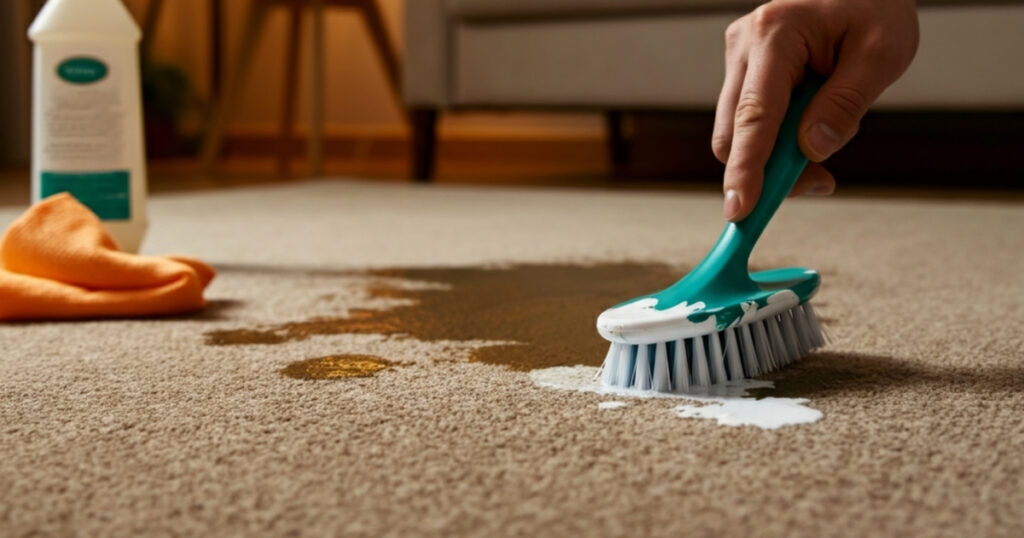
Dealing with a paint spill on your carpet can be stressful, but it doesn’t have to be a permanent problem. By acting quickly, identifying the paint type, and using the correct removal method, you can successfully tackle most paint stains. Always remember to test cleaning solutions on a hidden area first and to work in a well-ventilated space when using chemical solvents. With a little patience and the right approach, you can keep your carpets looking their best.
Frequently Asked Questions
1. Can vinegar remove paint from a carpet?
Yes, vinegar can sometimes work on wet, water-based paint stains. Its mild acidity can help break down the paint. Mix equal parts white vinegar and water, then blot the stain. However, it is generally less effective than soap and water or a dedicated solvent, especially for dried or oil-based paints.
2. Will rubbing alcohol damage my carpet?
No, rubbing alcohol is generally safe for most synthetic carpets, but it can potentially damage natural fibers or cause dye to bleed. It is crucial to test it on a small, inconspicuous area of your carpet first before applying it to the stain.
3. How can I get latex paint out of a carpet without a paint remover?
Yes, for wet latex paint, use a solution of warm water and dish soap. For dried latex paint, you can often soften it with rubbing alcohol or acetone before cleaning it with soap and water. These methods often work without needing a commercial paint remover.
4. Can I use a steam cleaner to remove paint?
No, you should not use a steam cleaner on a paint stain. The heat from a steam cleaner can actually set the stain permanently into the carpet fibers, making it nearly impossible to remove.
As an Amazon Associate, I earn from qualifying purchases.

